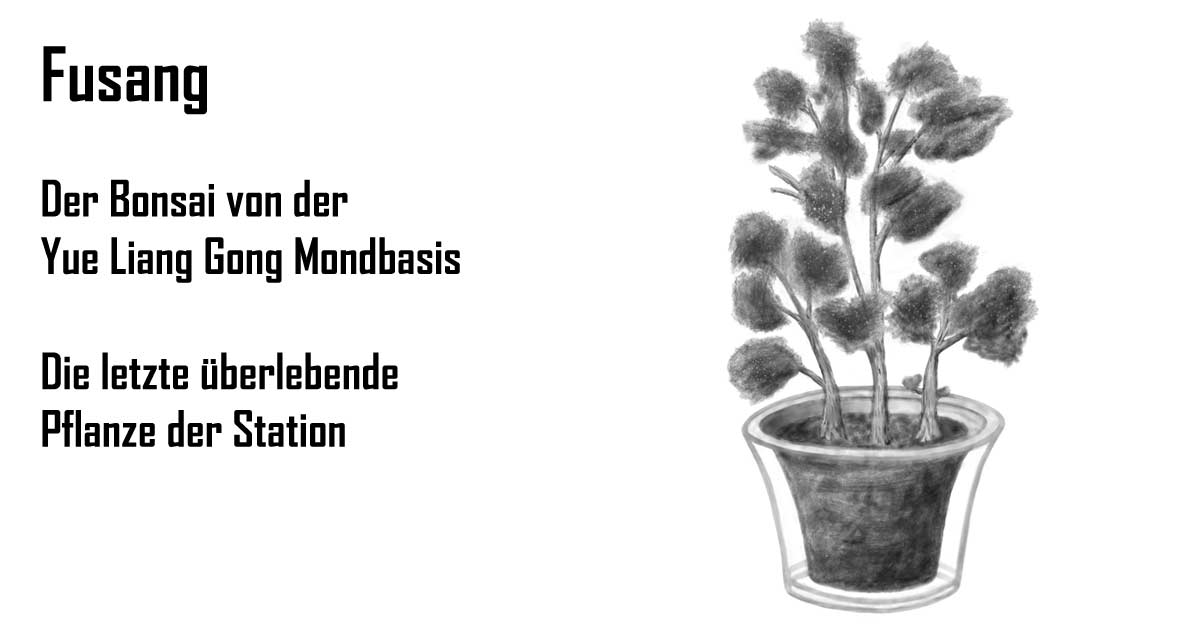
2091 Baum des Lebens

Ein Bonsai in einem transparenten Kunststoffbehälter von der Yue Liang Gong Mondbasis.
Die älteste und gleichzeitig letzte überlebende Pflanze der Station.
Der Bonsai war das Maskottchen der Hydroponik-Abteilung. Er kam als Setzling im Privatgepäck eines Taikonauten zur Mond-Station. Einige Jahre wurde die Pflanze ohne Wissen der Missionsleitung gepflegt. Die Mitarbeiter der Hydroponik zweigten Düngemittel und Mineralien vom Betrieb der Nutzpflanzen ab und im Lauf der Zeit gewannen sie etwas Muttererde aus kompostieren Pflanzenresten. Der Bonsai wurde immer stark beschnitten, um neben den Nutzpflanzen nicht aufzufallen. Aber im Jahr 2055 musste er aus dem Hydroponikgefäß in einen größeren Behälter umgesiedelt werden. Dafür druckte die Stationsbesatzung einen Blumentopf aus transparentem Plastik. Dieser Vorgang fiel der Missionsleitung auf. Bei der darauffolgenden Untersuchung wurde der Bonsai entdeckt.
Abläufe, Experimente und Ressourcenverbrauch waren damals, in der Frühzeit der Raumfahrt, sehr genau geregelt. Der Bonsai war aus Sicht der Missionsleitung ein irreguläres Experiment der Besatzung in Eigenregie. Die dafür aufgewendeten Ressourcen fehlten in der Gesamtplanung und darüber hinaus konnte die Missionsleitung solche unautorisierten Vorgänge grundsätzlich nicht dulden. Sie forderte die Rückführung des Biomaterials in den Stationskreislauf. Der damit beauftragte Hydroponik-Mitarbeiter widersetzte sich dem Befehl. Statt die Pflanze zu kompostieren, versteckte er sie hinter einer Konsolenverkleidung. Mit einer improvisierten Lampe und geringer Wasserzufuhr verging ein weiteres Jahr. Dann wurde die Pflanze wieder entdeckt.
Um der nun erneut drohenden Kompostierung zuvorzukommen, reichte die Stationsbesatzung einstimmig eine Petition ein, um "Fusang", den Baum des Lebens, zu retten. Der Text war ironisch und kurzweilig formuliert. Der Stil unterschied sich so sehr von den üblichen rationalen und knappen Missionsprotokollen, dass einige Mitarbeiter der Bodenstation ihn für eine besonders kreativ gestaltete Testnachricht hielten und nicht daran dachten, dass er unter die übliche Geheimhaltung fallen würde. Irgendwie gelangte die Petition in das öffentliche Netz, wo sie von einigen Leuten ernst genommen wurde. Der Text ging viral. Innerhalb weniger Tage entstand eine "rettet Fusang"-Bewegung in den sozialen Medien. Die psychologische Abteilung der Missionsleitung, setze sich schließlich dafür ein, den Bonsai offiziell als Experiment anzuerkennen und ihn damit vor der Kompostierung zu bewahren.
Zehn Jahre später ist die Yue Liang Gong Basis deutlich gewachsen. Sie hat eine ständige Besatzung von 20 Personen und bereitet eine weitere Verdopplung der Kapazität vor. Nuklear angetriebene Plasmatraktoren des chinesischen Raumfahrtprogramms pendeln zwischen Erd- und Mondorbit. Jeder bringt hunderte Tonnen Material zum Mond.
Dann bricht die Wirtschaft Anfang der 70er Jahre zusammen. Die Mittel für das ambitionierte Raumfahrtprogramm fehlen. Die Transporte zum Mond werden ausgesetzt. Zehn der 24 Taikonauten verlassen die Yue Liang Gong Station 2071 turnusgemäß. Es gibt kein Ersatzpersonal. Die Aufenthaltszeiten werden gestreckt, um die schwere Zeit zu überbrücken. Aber die Lage auf der Erde wird immer schlimmer. Im folgenden Jahr kehren weitere acht Taikonauten mit den Rettungskapseln der Station zum Erdorbit zurück. Weil der Frachtverkehr von der Erde zum Erliegen gekommen ist, fehlt die Transportkapazität, um die übrigen sechs zu evakuieren. Sie richten sich darauf ein, für lange Zeit auf der Station zu bleiben. Dabei profitieren sie von der stark erweiterten Lebenserhaltung und dem großen Lager, das eigentlich für 40 Personen vorgesehen waren. Die Hydroponik produziert zusätzlich Nahrungsmittel für zwanzig Personen. Überschüsse werden gefriergetrocknet und eingelagert. Das ist auf dem Mond einfach, bei Vakuum und -150 Grad Celsius im Schatten.
Die Versorgungslage ist gut. Aber die Wartung der Station ist ein Problem. Die Station ist zu groß für sechs Personen. Von den 40 Taikonauten beim Vollausbau waren 25 für Betrieb und Lebenserhaltung vorgesehen. Die Technik der Mondstation ist komplex. Im Prinzip ist sie eine Raumstation wie die alte ISS. Sie liegt zwar auf der Mondoberfläche, aber die Technik ist die gleiche.
Ohne den wissenschaftlichen Betrieb braucht man nur die Hälfte des Technikpersonals, etwa 12 Personen mit verschiedenen Spezialisierungen. Im Notfall reichen auch acht Techniker, wenn die richtigen Fähigkeiten dabei sind. Aber von den verbliebenen sechs sind nur vier aus dem Technikbereich. Nach einem Unfall bei einem Außeneinsatz 2078 sind sogar nur noch drei einsatzbereit. Das ist nicht genug. Nicht alle technischen Probleme können behoben werden. Im Lauf der Zeit gibt es immer mehr Ausfälle, die nicht repariert werden können. Und das Material altert. Es wird nicht wie geplant durch neuere Ausrüstung ersetzt. Besonders der Mondstaub macht Probleme. Reinigung von Geräten und Raumanzügen braucht viel Personal und Ressourcen. Das ist jetzt nicht mehr verfügbar. So wird jeder Außeneinsatz zum Risiko. Immer mehr Module werden undicht. Manche durch Mikrometeoriten, andere durch den allgegenwärtigen Mondstaub, der sich in Lager und Dichtungen setzt. Die Module müssen abgetrennt und versiegelt werden. Die Station fragmentiert. Es gibt Technikbereiche, die nur per Außeneinsatz erreichbar sind. Ein zusätzliches Hindernis für Wartungsarbeiten.
Und dann kommt es 2088 zum Reaktorschaden. Beim Zyklotron-Wandler des Fusionsreaktors fällt die Kühlung aus. Sie war schon seit Jahren nicht mehr überprüft worden. Die supraleitende Spule quencht, d.h. sie verliert die Supraleitfähigkeit und der Reststrom schmilzt die Spule. Der Reaktor schaltet automatisch ab. Vorher treffen noch schnelle Alphateilchen auf die umliegenden Geräte und die Wände. Der Bereich ist leicht radioaktiv. Kein Vergleich mit den Strahlungsniveaus von Spaltreaktoren. Aber mit den Mitteln der Station und dem verfügbaren Know-how ist der Schaden nicht zu reparieren. Strom kommt danach nur noch aus den alten Solarkollektoren.
Viele Anlagen, Stationsmodule und die Hydroponik mit ihrer Nahrungsmittelproduktion müssen stillgelegt werden. Der Bonsai "Fusang", der kleine Baum des Lebens, wird in das einzige noch aktive Wohnmodul umgezogen. Auch die Solarmodule bringen nur noch einen Bruchteil ihrer Nennleistung. Im Jahr 2090 wird die Situation unhaltbar. Die Lebensmittelvorräte gehen zur Neige, der Sauerstoff wird knapp, Außeneinsätze sind nicht mehr möglich. Die Station sendet Notrufe. Aber die sechs Taikonauten sind die letzten Menschen auf dem Mond. Es ist keine Hilfe zu erwarten.
Der Notruf wird auch im Erdorbit empfangen. Dort harren noch Menschen aus. Seit 20 Jahren überleben sie im sogenannten "Dher" (Müllhaufen). Module verschiedener Nationen, die nach dem Crash von der Erde abgeschnitten waren, haben sich bei der indischen Raumstation zusammengefunden. Zumindest soweit ihre Orbitalparameter eine Anpassung der Orbits zuließen. Der Dher organisiert eine Rettungsaktion. Eine improvisierte Rettungskapsel erreicht 2091 die Yue Liang Gong Mondbasis. Drei der letzten vier Taikonauten können gerettet werden. Sie erreichen nach einer dramatischen Reise den Dher im Erdorbit.
Achtzehn Jahre später betreten die ersten Taikonauten des neuen Raumfahrtprogramms der Zhu-Republik die Yue Liang Gong Basis. Im Eingang zum Wohnmodul finden sie Fusang. Der Bonsai steht mit seinem Plastiktopf mitten in der offenen Personenschleuse, schockgefroren und konserviert für die Ewigkeit.
Im Jahr 2115 wird die neue Zhu-Mondbasis in der Nähe der alten Yue Liang Gong Station eingerichtet. Anfangs ist sie nur klein, besetzt mit fünf Taikonauten und Fusang, der vorsichtig aufgetaut und wiederbelebt wird.
Neue Beiträge
2326 Kein interplanetarer Krieg
3050 Königliche Garde
3090 Solo Ehre
2234 Am Ende des Orbits
2248 Gemini-Katastrophe
2366 Orbitale Ökonomie
2222 Weltraumpiraten
2312 Kaio-Artefakt
3361 Erste Menschheit
2333 Metrische Impulsverstärkung
2337 Verschwörung im Orbit
2247 Quantensprung
2158 Space Patrol
2284 Trennung der Erde
2321 Isolation der Erde
2205 Unternehmensnationen
2192 Antiexpansionistischer Terror
2179 Private Asteroidenbasis
2231 Vereinte Planeten
2291 Verbotene Forschung
Die Besten
(20 von 75)
2158 Space Patrol
2179 Private Asteroidenbasis
2205 Unternehmensnationen
2231 Vereinte Planeten
2265 Öko-Militarismus
2291 Verbotene Forschung
2501 Extraplanetare Forschung
2532 Panik im Sonnensystem
2540 Mukhagni-Zwischenfall
2574 Artu-Domäne
2722 Sein Leben für die Kinder
2806 Weltraum Müll
2841 Leuchtender Tempel
2915 Belagerungskanone
2956 Chaosmanager
2969 1000 Jahre Mondlandung
3090 Solo Ehre
3296 Drachenlegenden
3361 Erste Menschheit
3365 Quantensprung
 2090
Adaptive Zusammenfassung
2090
Adaptive Zusammenfassung

 2094
Der Crash
2094
Der Crash